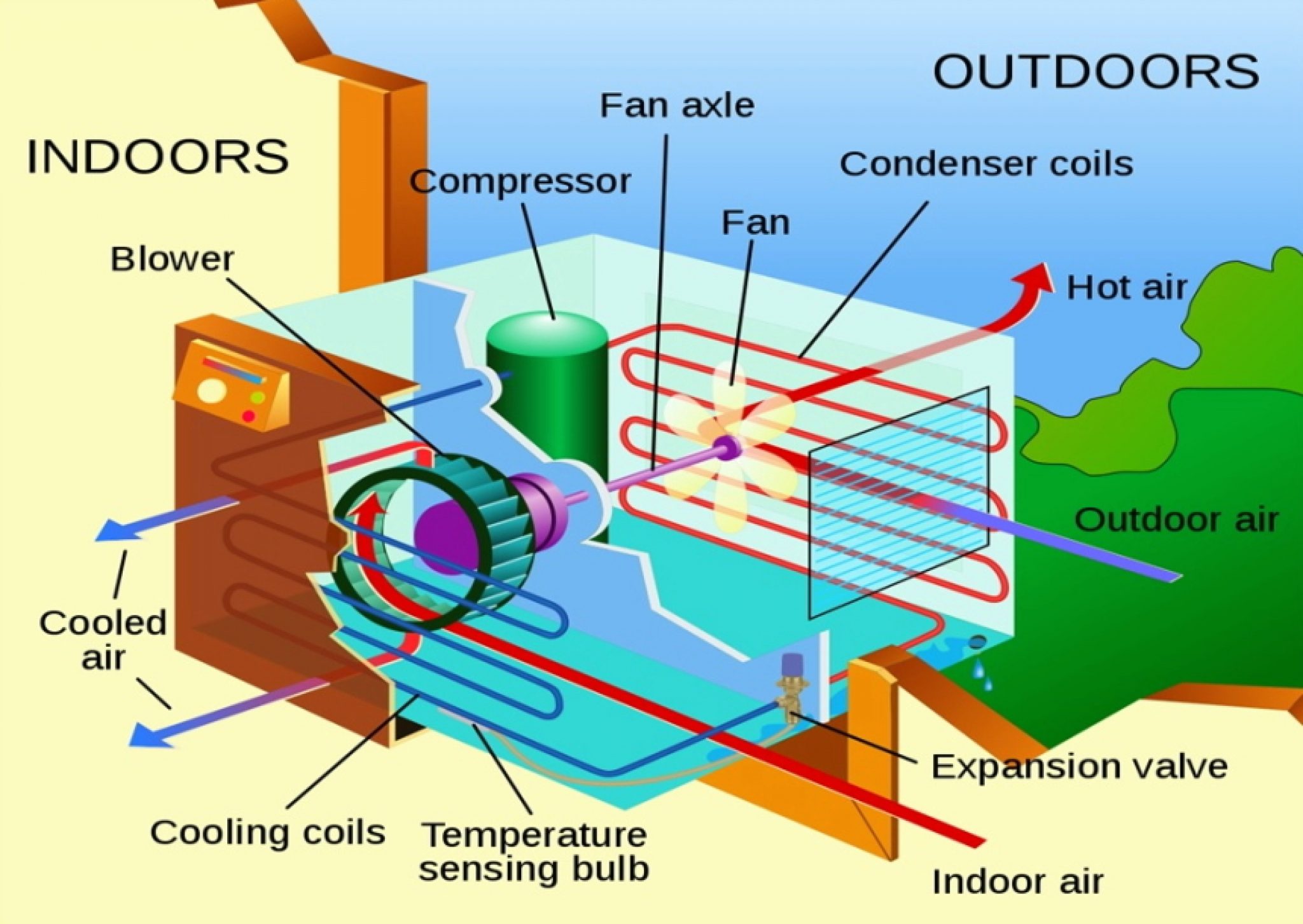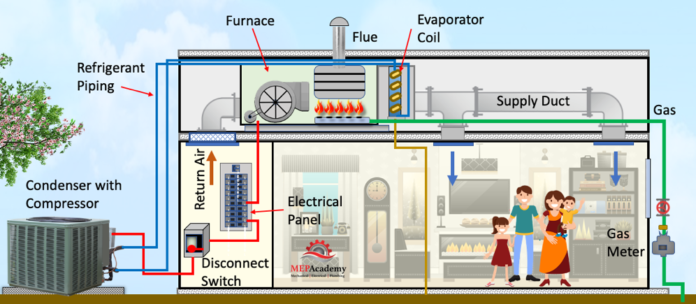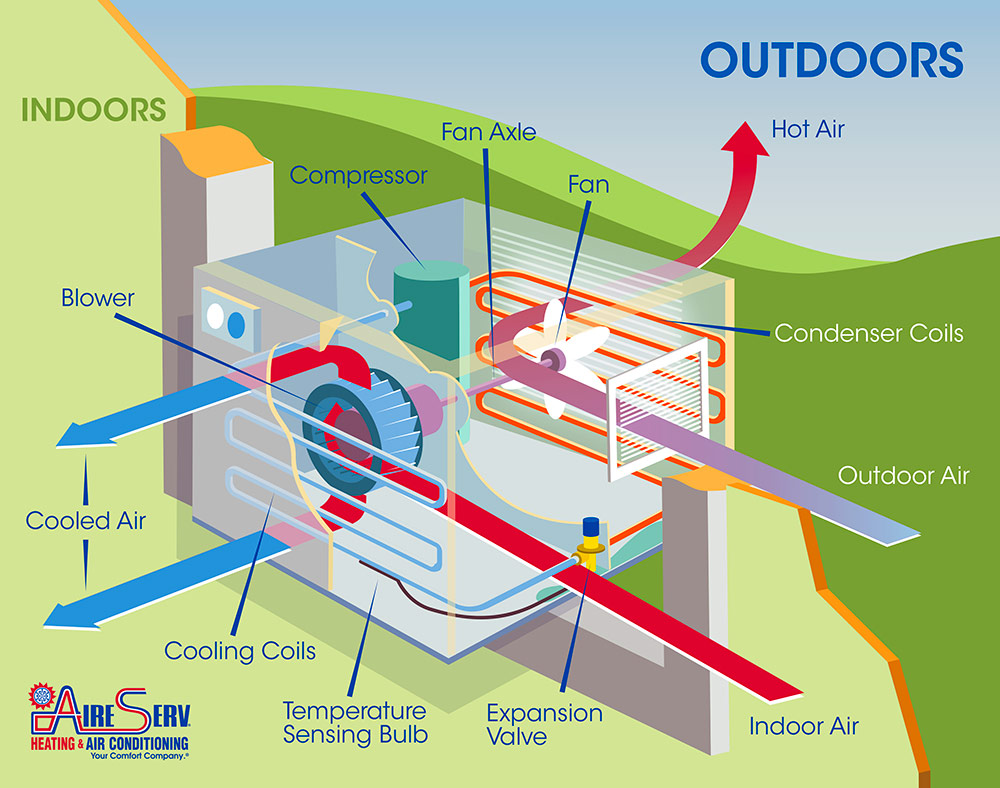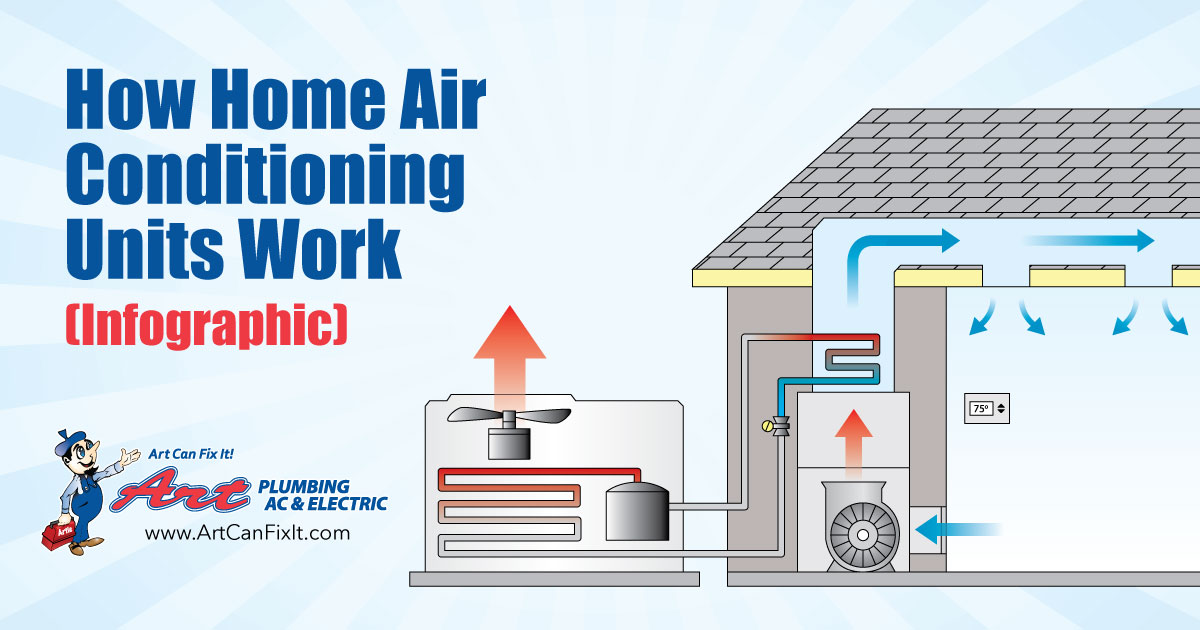How Does Air Conditioner Work In A House

Understanding how your home's air conditioner works can help you make informed decisions about its maintenance, repair, and even replacement. This guide breaks down the process into easy-to-understand steps, explaining the key components and how they interact to keep your home cool and comfortable.
The Basic Principle: Heat Transfer
At its core, air conditioning isn't about creating cold air. It's about removing heat from inside your house and transferring it outside. This process relies on a fundamental principle of physics: heat naturally flows from warmer areas to cooler areas. Your AC system acts as a facilitator, actively pumping heat out of your living space.
Think of it like this: imagine you have a bucket of warm water inside a cool room. The warm water will naturally lose heat to the cooler air. Your AC system does something similar, but instead of just letting heat dissipate passively, it actively *pumps* that heat out.
The Key Components: A Closer Look
An air conditioning system consists of several essential components that work together to achieve this heat transfer. These include:
1. Refrigerant
The refrigerant is the lifeblood of your AC system. It's a special fluid that circulates throughout the system, absorbing heat inside your home and releasing it outside. The refrigerant undergoes phase changes – from liquid to gas and back again – to facilitate this process.
Think of the refrigerant as a heat shuttle, constantly transporting heat from the indoor air to the outdoor environment.
2. Compressor
The compressor is the heart of the AC system. It's a powerful pump that circulates the refrigerant throughout the system. More importantly, it increases the pressure and temperature of the refrigerant gas. This is crucial for the refrigerant to release its heat effectively in the condenser coil.
The compressor is like the engine of a car, requiring significant power to operate and contributing to the overall energy consumption of your AC system.
3. Condenser Coil
The condenser coil is typically located in the outdoor unit. It's a series of finned tubes where the hot, high-pressure refrigerant gas releases its heat to the outside air. A fan blows air across the condenser coil to facilitate this heat transfer.
As the refrigerant releases heat, it changes back from a gas to a high-pressure liquid. This process is similar to how a car radiator releases heat from the engine coolant.
4. Expansion Valve (or Metering Device)
The expansion valve (also known as a metering device) is a small but crucial component that regulates the flow of refrigerant into the evaporator coil. It reduces the pressure of the refrigerant, causing it to cool down significantly.
Think of the expansion valve like a nozzle on a garden hose. By restricting the flow, it creates a pressure drop, which in turn causes the refrigerant to become much colder.
5. Evaporator Coil
The evaporator coil is located in the indoor unit, usually within your furnace or air handler. Here, the cold, low-pressure refrigerant absorbs heat from the indoor air that is blown across the coil. As the refrigerant absorbs heat, it evaporates from a liquid to a gas.
This is the part of the system that actually cools the air that circulates through your home. The evaporator coil essentially "steals" heat from the air, leaving behind cooler air.
6. Air Handler (or Furnace)
The air handler is responsible for circulating air throughout your home's ductwork. It contains a blower fan that pushes air across the evaporator coil, cooling it down before distributing it to the different rooms.
In many homes, the furnace also serves as the air handler for the air conditioning system. The furnace blower fan simply runs even when the furnace isn't actively heating the air.
7. Thermostat
The thermostat is the control center of your AC system. It senses the temperature in your home and signals the system to turn on or off to maintain the desired temperature. Modern thermostats can be programmable and even remotely controlled, allowing for greater energy efficiency.
The thermostat is the brain of the operation, telling the AC system when to work and when to rest.
The Cooling Cycle: Step-by-Step
Now that we've looked at the individual components, let's trace the cooling cycle step-by-step:
- Refrigerant Absorption: The cycle begins in the evaporator coil inside your home. Cold, low-pressure refrigerant absorbs heat from the indoor air blowing across the coil. This turns the refrigerant into a low-pressure, warm gas.
- Compression: The warm refrigerant gas travels to the compressor, where it's pressurized and heated further. This high-pressure, hot gas is now ready to release its heat.
- Heat Rejection: The high-pressure, hot refrigerant gas flows to the condenser coil outside your home. Here, it releases its heat to the outdoor air, aided by the condenser fan. As it releases heat, the refrigerant condenses back into a high-pressure, warm liquid.
- Pressure Reduction: The high-pressure, warm liquid refrigerant travels to the expansion valve. The valve reduces the pressure of the refrigerant, causing it to cool down significantly and become a cold, low-pressure liquid.
- The Cycle Repeats: The cold, low-pressure liquid refrigerant returns to the evaporator coil, ready to absorb more heat and repeat the cycle.
Maintaining Your AC System: Ensuring Efficiency and Longevity
Proper maintenance is crucial for ensuring your AC system operates efficiently, prolonging its lifespan, and preventing costly repairs. Here are some key maintenance tasks:
- Regular Filter Changes: Replacing your air filter regularly (typically every 1-3 months) is one of the most important things you can do. A dirty filter restricts airflow, making your system work harder and reducing its efficiency. It can also lead to frozen coils and other problems.
- Coil Cleaning: The condenser and evaporator coils can accumulate dirt and debris over time, reducing their ability to transfer heat. Periodically cleaning these coils with a soft brush or coil cleaner can improve efficiency.
- Professional Tune-Ups: Schedule annual tune-ups with a qualified HVAC technician. They can inspect your system for leaks, check refrigerant levels, lubricate moving parts, and ensure everything is operating correctly.
- Clear Debris Around Outdoor Unit: Ensure there's ample space around the outdoor unit for proper airflow. Remove any plants, bushes, or other obstructions that could block the airflow.
- Ductwork Inspection: Have your ductwork inspected for leaks and damage. Leaky ducts can waste a significant amount of energy, making your AC system less efficient.
Making Informed Decisions: Understanding Efficiency Ratings
When it comes to replacing your AC system, understanding efficiency ratings is crucial. The two most common ratings are:
- SEER (Seasonal Energy Efficiency Ratio): This rating measures the cooling efficiency of an AC system over an entire cooling season. The higher the SEER rating, the more efficient the system. The minimum SEER rating currently required for new AC systems in the United States is 14.
- EER (Energy Efficiency Ratio): This rating measures the cooling efficiency of an AC system at a specific set of operating conditions (e.g., a certain outdoor temperature and humidity level). EER is a good indicator of efficiency on hot days.
Choosing an AC system with a higher SEER rating can save you money on your energy bills over the long term. However, it's important to consider the upfront cost of the system and how long you plan to stay in your home.
Troubleshooting Common AC Problems
Even with proper maintenance, AC systems can sometimes experience problems. Here are some common issues and potential solutions:
- AC Not Cooling: Check the thermostat settings, air filter, and circuit breaker. A refrigerant leak or compressor problem could also be the cause.
- AC Blowing Warm Air: This could be due to a frozen evaporator coil, low refrigerant levels, or a malfunctioning compressor.
- AC Making Strange Noises: Noises like banging, hissing, or grinding can indicate a variety of problems, such as a loose part, refrigerant leak, or compressor failure.
- AC Leaking Water: This could be due to a clogged condensate drain line.
- High Energy Bills: A dirty air filter, leaky ducts, or an inefficient AC system can all contribute to high energy bills.
If you encounter any of these problems, it's best to consult with a qualified HVAC technician for diagnosis and repair. Trying to fix complex AC problems yourself can be dangerous and may void your warranty.
By understanding how your air conditioner works and following proper maintenance practices, you can keep your home cool and comfortable while saving money on your energy bills. Remember to consult with a qualified HVAC professional for any major repairs or replacements.








:max_bytes(150000):strip_icc()/what-are-central-air-conditioners-1152645_V2-390c6f1f6ca14b4ebc59426f226a78a8.png)

